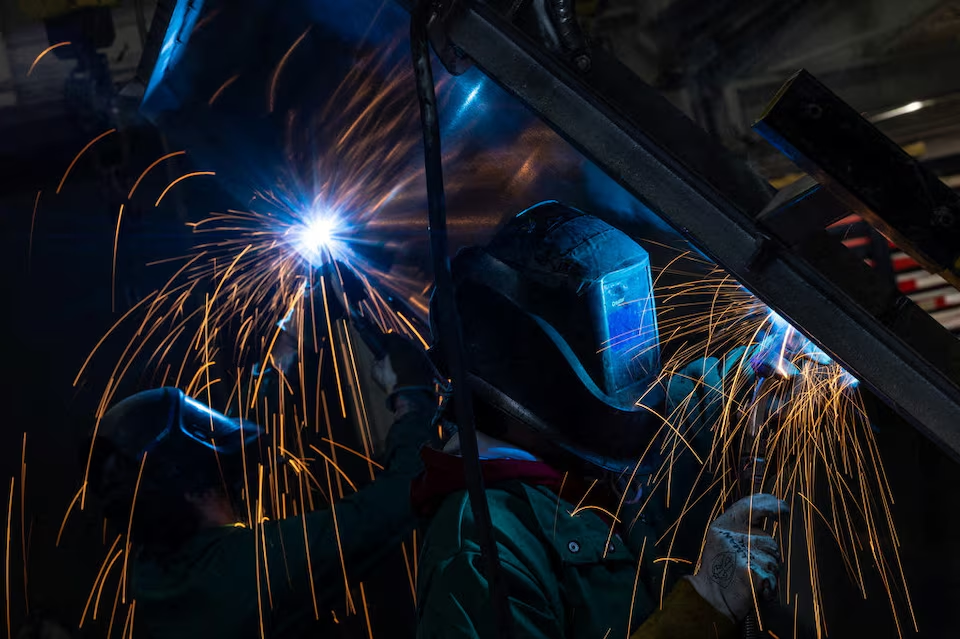
Navigating the Storm: Manufacturing Woes and What It Means for American Workers
New York’s manufacturing contraction is more than a regional issue—it signals deepening problems for the U.S. labor market. With new orders declining, inflation soaring, and tariffs compounding uncertainty, American workers face rising job insecurity and financial stress. This blog explores the ripple effects of economic policy on everyday lives and highlights the need for collective support and smarter trade decisions.
The recent decline in New York’s manufacturing sector and its implications for the broader US economy and labor market. We’ll delve into how tariff uncertainty, inflation pressures, and contract expectations could lead to a significant shift in employment and wages. Personal anecdotes and unique insights will illustrate the situation’s broader social and economic context.
As I sip my morning coffee and read the latest economic bulletins, I can’t help but reflect on the turbulence of the past few years. With the manufacturing landscape shifting dramatically, particularly in New York, the implications for American workers become increasingly severe. Memories of the pre-pandemic economy surge back, contrasting sharply with the uncertainties we face today. This post aims to unpack what’s happening in the manufacturing sector and its potential fallout for jobs across the country.
The Current State of New York’s Manufacturing Sector
New York’s manufacturing sector is facing some serious challenges. Recently, we learned that manufacturing has contracted for the second consecutive month. This isn’t just a minor hiccup; it’s a significant trend that raises concerns about the future of the industry in the state.
Understanding the Decline
According to the latest report from the Federal Reserve Bank of New York, the business outlook has dropped to its lowest point since 2001. That’s a staggering statistic. A 22% drop in business outlook is not something we can ignore. It’s primarily due to the effects of tariffs imposed by the previous administration. These tariffs have created uncertainty and instability in the market.
But what does this mean for manufacturers? Well, it means that a dramatic decline in orders and shipments is anticipated over the next six months. This is not just a prediction; it’s a reality that many manufacturers are already feeling. The sentiment among manufacturers is troubling, to say the least.
What Are the Implications?
When we think about the implications of this downturn, several questions come to mind:
- How will this affect jobs in the manufacturing sector?
- What does this mean for the economy of New York State?
- Are there any signs of recovery on the horizon?
These questions are crucial. The manufacturing sector is a significant part of New York’s economy. A decline in this area can ripple through various industries, affecting everything from employment rates to local businesses. It’s a domino effect that can lead to broader economic challenges.
Historical Context
To understand the current situation, we need to look at the historical context of manufacturing fluctuations. Manufacturing has always had its ups and downs. However, the recent contraction feels different. It’s not just a seasonal dip; it’s a reflection of deeper issues in the market.
As we analyze the data, we see that the outlook for business conditions slumped more than 20 points to minus 7.4. This indicates a severe downturn. It’s a stark reminder of how quickly things can change in the manufacturing landscape.
Looking Ahead
So, what can we expect in the coming months? The projections are not optimistic. A decrease in orders is projected for the next six months. This means that manufacturers will likely face even more challenges ahead. It’s a tough pill to swallow, especially for those who rely on this sector for their livelihoods.
As we navigate through this uncertainty, it’s essential to stay informed. Understanding the factors at play can help us prepare for what’s next. The effects of tariffs are still being felt, and it’s clear that the manufacturing sector in New York is at a crossroads.
The current state of New York’s manufacturing sector is concerning. With a contraction for two consecutive months and a significant drop in business outlook, we must pay attention. The future may hold more challenges, but awareness and understanding can help us face them head-on.
The Ripple Effect: Tariff Uncertainties and Labor Market Challenges
In today’s economy, the impact of tariff policies is hard to ignore. Manufacturers are feeling the pressure. They are reassessing their future operations. Why? Because the uncertainty surrounding tariffs is causing chaos in the sector. This isn’t just a minor inconvenience; it’s a significant shift that could reshape the landscape of manufacturing.
Understanding the Current Landscape
Let’s break it down. Tariff policies are not just numbers on a page. They have real-world implications. When tariffs increase, manufacturers often face higher costs. This leads to a reassessment of their operations. They might consider moving production overseas or cutting back on hiring. The ripple effect is profound.
- Manufacturers are reassessing future operations.
- New order declines are linked to impending job cuts.
- Workers are increasingly fearful of job loss.
It’s a cycle that feeds on itself. As manufacturers pull back, new orders decline. This decline can lead to layoffs. And as layoffs loom, workers become anxious. They worry about their job security. This fear is palpable in the manufacturing sector today.
Historical Context
To understand the current situation, we can look back at previous economic downturns. History often provides valuable lessons. For instance, during past recessions, we saw similar patterns. Tariffs were implemented, and manufacturers faced uncertainty. The result? Job losses and economic stagnation.
In fact, new orders have decreased to their lowest levels since 2001. That’s a staggering statistic. It shows just how serious the situation is. Manufacturers are stating that the current administration’s policies are causing significant chaos in the sector. This chaos is not just a buzzword; it’s a reality that many are facing.
The Fear Factor
Now, let’s talk about fear. It’s a powerful emotion. In the manufacturing sector, workers are feeling it more than ever. The uncertainty surrounding tariffs is causing anxiety about job security. Many are asking themselves: “Will I still have a job next month?”
This fear is not unfounded. With expected layoffs in the manufacturing sector, the stakes are high. Workers are left wondering how they will support their families. The emotional toll can be just as damaging as the economic one.
What’s Next?
As we look ahead, it’s clear that the current administration’s policies are causing chaos. This chaos leads to plunges in demand for products and labor. Manufacturers are caught in a tough spot. They must navigate these turbulent waters while trying to maintain their workforce.
So, what can be done? It’s a complex issue. Policymakers need to consider the long-term effects of tariffs. They must weigh the benefits against the potential job losses. It’s a balancing act that requires careful thought.
In conclusion, the ripple effect of tariff uncertainties is real. Manufacturers are reassessing their operations, and workers are feeling the strain. The fear of job loss is palpable, and the data supports these concerns. As we move forward, it’s essential to keep these challenges in mind. The future of the manufacturing sector depends on it.
Worker Experience: The Human Side of Economic Collapse
As we navigate through these turbulent economic times, the stories of laid-off workers resonate deeply. Their experiences are not just statistics; they are real lives affected by decisions made far above their heads. I want to share some of these personal stories, highlighting the struggles faced by many. The impacts on mental and financial wellbeing are profound, and we must acknowledge them.
Personal Stories of Struggle
Imagine waking up one day to find that your job is gone. For many, this is not just a nightmare; it’s a reality. Workers across various sectors are facing layoffs, and the emotional toll is staggering. I’ve spoken to individuals who have dedicated years to their companies, only to be told that their positions are no longer needed. This sudden shift leaves them feeling lost and uncertain.
One worker I spoke with shared, “For workers, their worst nightmare is about to come true with layoffs and reduced hours.” This sentiment echoes throughout the workforce. The fear of unemployment looms large, and it’s not just about losing a paycheck. It’s about losing a sense of purpose and identity.
The Mental and Financial Toll
The impacts of layoffs extend beyond the immediate loss of income. Mental health issues are on the rise. Workers are grappling with anxiety, depression, and feelings of inadequacy. The financial strain adds another layer of stress. Many are struggling to make ends meet, with bills piling up and savings dwindling.
- Increased anxiety: The uncertainty of the job market creates a constant state of worry.
- Depression: The loss of a job can lead to feelings of hopelessness.
- Financial strain: Many workers are forced to dip into savings or rely on credit cards.
As inflation rates soar, the situation becomes even more dire. Workers are finding that their real-life expectations are diminishing. What once seemed like a stable job now feels precarious. The cost of living continues to rise, but wages are stagnant. This disconnect creates a sense of despair among many.
Community Resilience and Support Systems
In the face of these challenges, community resilience shines through. Support systems are crucial during these times. Many organizations are stepping up to provide assistance. From food banks to job training programs, communities are coming together to help those in need.
We must also recognize the importance of mental health support. Counseling services and support groups can provide a safe space for individuals to share their experiences and feelings. It’s essential to foster an environment where people feel comfortable discussing their struggles.
Economic Data: A Broader Perspective
To understand the collective experience, we must look at the data. Currently, the percentage of workers reporting job insecurity is at an all-time high. This statistic is alarming and reflects the broader economic landscape. Additionally, inflation rates are at their highest in two decades. These numbers are not just figures; they represent real people facing real challenges.
As manufacturing begins its contraction, the highly affected workforce is struggling to cope with increasing financial pressures and fears of unemployment. The ripple effects of these economic changes are felt in every corner of society.
In conclusion, the human side of economic collapse is often overlooked. The personal stories of laid-off workers remind us that behind every statistic is a life profoundly affected. The impacts on mental and financial wellbeing are significant, and we must address these issues with empathy and understanding. As we move forward, let’s prioritize community support and resilience. Together, we can navigate these challenging times and emerge stronger.
TL;DR: New York’s declining manufacturing sector signals troubling trends for the US labor market, compounded by tariff uncertainty and inflation. As expectations for new orders shrink, workers may face shrinking paychecks and job insecurity.
NewYorkManufacturingDecline, ImpactOfTariffsOnEconomy, LaborMarketChallenges, InflationAndHourlyEarnings, USLaborMarketOutlook, TariffUncertainty, CurrentEmploymentTrends, ManufacturingSectorAnalysis, USEconomicForecast2024
#LaborMarketChallenges, #TariffUncertainty, #USEconomicForecast2024, #CurrentEmploymentTrends, #InflationAndHourlyEarnings, #ImpactOfTariffsOnEconomy, #NewYorkManufacturingDecline, #ManufacturingSectorAnalysis, #USLaborMarketOutlook,#ManufacturingCrisis, #USJobs, #LaborMarket, #WorkerStruggles, #EconomicDownturn, #Inflation, #TariffImpact, #NewYorkManufacturing, #Layoffs2025, #RecessionWarning

